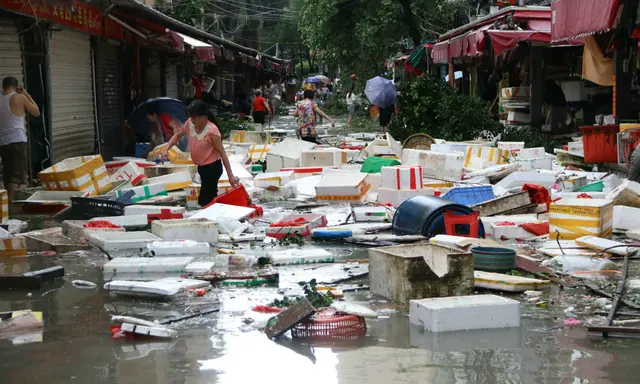Typhoon Meranti made landfall in Xiang'an district of Xiamen City, east China's Fujian Province, at 3:05 a.m. Thursday, with gales up to 48 meters per second.
The world's strongest typhoon so far this year has also been monitored as the strongest one hitting southern Fujian Province since the local meteorological records were kept in 1949.
Vehicles are crushed by broken electric line poles in typhoon-hit Taiwan, southeast China, Sept. 14, 2016. Photo: Xinhua
The winds shattered windows on high buildings, causing disruption of tap water supplies in many communities in Xiamen.
China's National Marine Environmental Forecasting Center (NMEFC) upgraded its warning for ocean waves triggered by Typhoon Meranti to "red" on Wednesday, the highest alert in a four-color warning system.
"The winds and rain got extremely loud after 3 a.m. The cracking sound of windows and tree branches were also scary. The power went out in the shop for several times," said Su Binglin, a night-shift shop assistant at a 24-hour convenient store.
He said he had to use a metal plate to strengthen the shop door to prevent it from shattering. He also used boxes filled with mineral water to consolidate the plate.
At around 6 a.m., the winds abated. Streets in Xiamen are scattered with glass shards, broken tree branches and blown down billboards.
"It is so wretched. Many trees by road sides are fallen, and there are also pondings blocking traffic," said Hu Rong, a delivery man.
Ships are seen at the port in Kaohsiung, southeast China's Taiwan, Sept. 14, 2016. Photo: Xinhua
The Xiamen Power Supply Co. said that the typhoon has made severe damages to the power grid in Xiamen, causing mass blackout. The electricity supply was also disrupted in Xiamen's outlying islands. As the typhoon is further plowing inland, more damages of the power network are likely.
Thursday coincided with China's Mid-Autumn Festival, which gives a three-day public holiday. Schools and kindergartens in coastal cities of Fuzhou, Xiamen, Zhangzhou, Quanzhou and Putian in Fujian were closed Wednesday in precaution against the typhoon.
The railway authorities in Nanchang, east China's Jiangxi Province, announced Wednesday to cancel 144 trains that had been scheduled between Wednesday to Saturday to southern and eastern cities in an emergent response to the typhoon.
Schools and kindergartens in coastal cities of Fuzhou, Xiamen, Zhangzhou, Quanzhou and Putian were closed Wednesday.
Electric line poles are blown down on a highway from Pingtung to Kenting in typhoon-hit Taiwan, southeast China, Sept. 14, 2016. Photo: Xinhua
"The typhoon will bring gales and heavy rain when it makes landfall," Li said. "Parents are advised to keep children indoors and stay away from unsafe houses and advertising boards."
Provincial-level officials in Fujian are leading 13 work teams for disaster prevention work in areas most likely to be hit by the typhoon.
More than 40,000 people have been evacuated from low-lying districts in Zhangpu County, which is close to the sea.
Industrial production, classes and businesses have been suspended in Xiamen, a coastal city in Fujian.
Passenger liners on eight routes between Fujian and Taiwan were canceled on Wednesday, as were at least 175 flights in and out of Fujian.
According to Chen Jianping, an official with Guangzhou Railway Group, services of many passenger trains have been stopped. Passengers may have their tickets refunded at railway stations.
More than 4,000 workers are patrolling railways to monitor potential risks, Chen said.
Under China's four-tier severe weather warning system, red is the most serious, followed by orange, yellow and blue.
(APD)
 简体中文
简体中文

